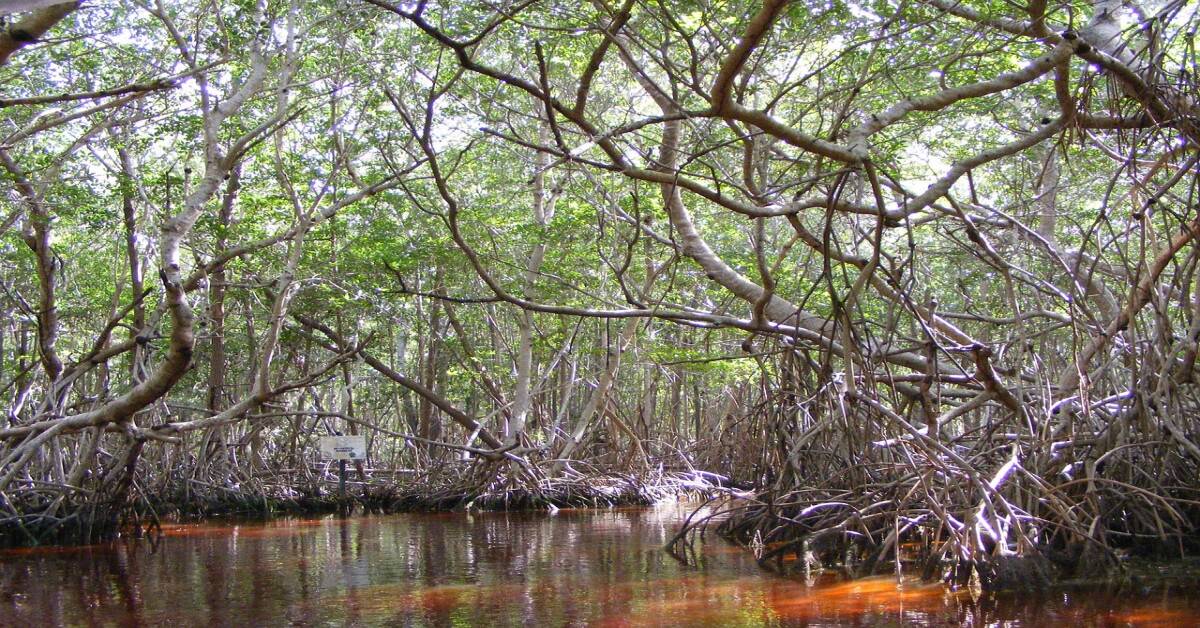Mangrove forests are unique coastal ecosystems found in tropical and subtropical regions. These forests play a crucial role in protecting shorelines from erosion and storm surges. In this post, we’ll explore mangrove forest structure and features, focusing on how these ecosystems are vital for both the environment and wildlife.
The structure of mangrove forests is distinct, with trees that grow in saline water and have specialized roots. These roots, such as stilt and aerial roots, allow mangroves to survive in harsh conditions. Their dense root systems also help stabilize coastlines and reduce wave impact.
Besides their structural importance, mangrove forests provide habitats for various species. Birds, fish, and other animals rely on them for food and shelter. This combination of features makes mangroves essential to the health of coastal ecosystems.
What are Mangrove Forests?
Mangrove forests are coastal ecosystems made up of salt-tolerant trees and shrubs that thrive in tropical and subtropical regions. These forests grow in areas where saltwater meets land, like along coastlines, riverbanks, and estuaries.
Mangrove forests are adapted to survive in harsh conditions, including high salinity, waterlogged soils, and low oxygen levels. This ability to endure such environments makes them unique and essential to coastal ecosystems.
One of the key characteristics of mangrove forests is their complex root systems. These roots, such as stilt or aerial roots, allow mangrove trees to absorb oxygen even in waterlogged soil.
Additionally, they help protect shorelines by reducing erosion and stabilizing sediments. Mangrove forests also act as nurseries for many marine species, offering shelter and food.
Besides their ecological significance, mangroves provide valuable services to humans. They act as natural barriers, reducing the impact of waves and storms.
Furthermore, their ability to store carbon makes them important in the fight against climate change. These characteristics of mangrove forests make them vital for both environmental health and human survival.

Mangrove Forest Structure and Features
Mangrove forests have a unique structure that allows them to thrive in harsh environments. The structure of mangrove forests includes several key adaptations that enable the trees to survive in saline, waterlogged areas along coastlines.
Adaptation to Saline Environments
Mangrove trees have developed specialized roots and leaves to survive in salty, oxygen-poor soils. Their roots filter saltwater, while their leaves can excrete excess salt, helping them survive in coastal zones where other plants cannot.
Forest Layers
Mangrove forests are organized into three main layers. The canopy consists of the upper branches and leaves of the trees, which provide shade and habitat for many animals.
Below the canopy is the understory, a mix of smaller plants and younger trees that thrive in the shaded environment. The lowest layer is the root structure, where mangrove roots are exposed to both air and water, helping stabilize the shoreline.
Key Features
Mangroves have distinct roots that contribute to their stability and survival. Stilt roots grow from the trunk and provide support, preventing trees from being uprooted by tides.
Pneumatophores, or air-breathing roots, stick out of the soil to capture oxygen in waterlogged areas. These features not only help the trees survive but also stabilize sediments, reducing coastal erosion and protecting shorelines from storms.
Also Read: Harmful Consequences of Forest Fires
Where Mangroves Forests Grow?
Mangroves thrive in specific environmental conditions that are essential for their survival. These forests are commonly found in areas with high salinity, as they are well adapted to filter salt from the water they absorb.
They are also present in regions with a wide tidal range, where tides regularly submerge and expose their roots. This tidal fluctuation is crucial because it allows the mangrove roots to access oxygen, which is typically limited in waterlogged soils.
Mangroves grow in muddy, oxygen-poor soils where many other plants cannot survive. The dense, anaerobic muds in which mangroves root themselves lack oxygen, but mangroves adapt by developing specialized roots like pneumatophores.
These roots allow the trees to breathe even when submerged. The combination of salinity, tidal exposure, and poor soil creates a challenging environment that few species can tolerate.
However, these conditions contribute to the unique characteristics of mangrove forests. The ability to grow in such harsh conditions helps create ecosystems that provide shelter for fish, crabs, and birds, while also offering natural coastal protection against erosion and storms. These factors make mangroves invaluable to coastal environments.
Mangrove Forest Location
Mangrove forests are found along tropical and subtropical coastlines worldwide. These forests are most abundant in regions like Southeast Asia, which holds the largest concentration of mangroves, particularly in countries like Indonesia, Thailand, and the Philippines.
West Africa also has extensive mangrove systems, notably in Nigeria and Guinea. In the Americas, mangroves are common along the coasts of Central and South America, with significant forests in Brazil, Mexico, and Ecuador.
Mangroves thrive in coastal areas with warm climates, where temperatures rarely fall below freezing. These regions provide the ideal combination of tropical and subtropical climates, along with the high salinity and tidal fluctuations necessary for mangrove growth.
The ability to adapt to these harsh conditions allows mangroves to form dense forests along coastlines, estuaries, and river deltas, providing critical ecological services in these areas.
Ecological Importance of Mangrove Forests
Mangrove forests play a vital role in ecological balance by providing essential habitats for many species. These forests are home to diverse wildlife, including birds, fish, crabs, and other marine species that depend on mangroves for food and shelter.
Furthermore, mangroves help prevent coastal erosion by stabilizing sediments with their extensive root systems. This reduces the impact of waves and storm surges, protecting coastal communities.
Mangroves also serve as significant carbon sinks, storing large amounts of carbon in their biomass and the surrounding soils. This ability helps combat climate change by reducing atmospheric carbon levels.
The rich biodiversity and the mangroves’ capacity to buffer storm impacts are key characteristics of mangrove forests, making them ecologically essential for maintaining the health of coastal environments.
Threats to Mangrove Forests
Mangrove forests face significant threats from both human activities and environmental changes. Deforestation for agriculture, aquaculture, and urban development has destroyed vast areas of mangrove forests.
Additionally, climate change poses a serious threat as rising sea levels and stronger storms increase the vulnerability of these coastal ecosystems. Pollution, especially from industrial runoff and plastics, further degrades mangrove environments.
These threats directly impact the structure and features of mangrove forests, leading to reduced biodiversity, weakened shorelines, and loss of crucial ecosystem services.
If these forests continue to degrade, coastal regions will become more vulnerable to erosion and natural disasters, and many species will lose their habitats.
Conservation Efforts and Future Outlook
Efforts to protect and restore mangrove forests are increasing worldwide. In India, for example, initiatives like the Mangrove for the Future (MFF) program have made significant strides in restoring degraded mangrove areas.
Additionally, community-based mangrove restoration projects have been successful in areas like the Sundarbans, where local participation has led to the replanting of vast forest areas.
Conservation is essential to preserving the unique characteristics of mangrove forests for future generations. By protecting these ecosystems, we not only safeguard biodiversity but also strengthen natural defenses against climate change.
Continuous restoration and conservation efforts are crucial for maintaining the balance of these vital ecosystems.
Conclusion
Mangrove forests have a unique structure and essential features that help them thrive in harsh coastal environments. Their specialized roots, layers, and ability to survive in high salinity and oxygen-poor soils make them vital to coastal ecosystems.
These forests provide shelter for wildlife, stabilize shorelines, and act as natural buffers against storms. Besides, they play a crucial role in carbon storage, making them important for combating climate change.
Protecting mangrove forests is essential to preserving their benefits for both nature and people.
Without conservation efforts, these ecosystems will continue to degrade, leading to the loss of biodiversity and increased vulnerability to coastal erosion. Therefore, safeguarding mangroves ensures a healthy environment and protects communities from future environmental challenges.






